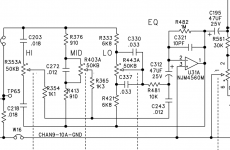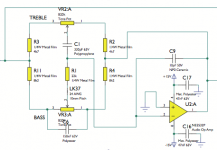Hi,
I'm looking to build a baxandall eq. The design seems to be very simple and well know. But, looking at some schematics I found two different topologies which I can't tell the difference. Changing the caps and resistor values, the two filters seems to work equal.
It's hard to explain the difference, so I'm sending to schematics. One of them have the mid control but let's stick on highs and lows. They are a bit different.
Is there any advantage by using one or another?
I'm looking to build a baxandall eq. The design seems to be very simple and well know. But, looking at some schematics I found two different topologies which I can't tell the difference. Changing the caps and resistor values, the two filters seems to work equal.
It's hard to explain the difference, so I'm sending to schematics. One of them have the mid control but let's stick on highs and lows. They are a bit different.
Is there any advantage by using one or another?
Attachments
You may also be interested in the stepped tilt (as per QUAD) tone control module offered by John Broskie. See the hyperlinks below.
Tilt Control
GlassWare Tilt Control
New GlassWare Tilt Control Kit
Tilt Control
GlassWare Tilt Control
New GlassWare Tilt Control Kit
Ken, thank you. =)
But I'd like to understand the differences between the two circuits above before looking to new models. It's driving me crazy. LOL
But I'd like to understand the differences between the two circuits above before looking to new models. It's driving me crazy. LOL
In mid position both circuits are equivalent. At end (high or low) position both circuits are equivalent. That only leaves intermedate pot positions where there could be a difference - but my guess is that they may turn out to be equivalent there too, at least for the treble control.
For example, consider the treble control at mid position. In either case you have a 1:1 potential divider between input and output, with some resistance and some capacitance in series/parallel.
For example, consider the treble control at mid position. In either case you have a 1:1 potential divider between input and output, with some resistance and some capacitance in series/parallel.
- Status
- Not open for further replies.


